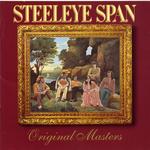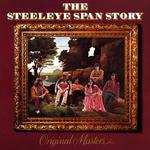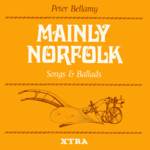> Steeleye Span > Records > Original Masters
Steeleye Span: Original Masters
 |
Original Masters Chrysalis CJT 3 (2 LP, UK, 1977) |
 |
The Steeleye Span Story Chrysalis V2X 41136 (2 LP, USA, 1977) |
A two-record compilation of tracks from the first nine Steeleye Span albums, known as Original Masters in the UK and—with some different tracks—as The Steeleye Span Story in the US. All tracks have been published in the Original Masters songbook.
Tracks
Chrysalis UK / BGO Album
The Chrysalis UK double album and the BGO double CD Original Masters—presumably the original version, whatever that means in this context—has 18 tracks from Steeleye Span records plus the previously unreleased Bonny Moorhen (an out-track from the Parcel of Rogues recording sessions) and a live version of The Wife of Ushers Well, recorded at the Rainbow Theatre, London in November 1974. According to the Original Masters songbook, the song Blackleg Miner should have been on the album too but had to be left out for copyright reasons.
Side 1 / CD 1
- Sir James the Rose (Roud 2274; Child 213; G/D 2:235) (6.10)
- Black Jack Davy (Roud 1; Child 200; G/D 2:278; Henry H124) (4.17)
- All Around My Hat (Roud 22518) (4.09)
- The Wife of Ushers Well (Roud 196; Child 79) (4.45)
- Fighting for Strangers (Roud 602) (4.16)
Side 2 / CD 1
- Thomas the Rhymer (Roud 219; Child 37) (3.16)
- Seven Hundred Elves (DgF 52D) (5.17)
- Long Lankin (Roud 6; Child 93; G/D 2:187; Henry H735) (8.30)
- Elf Call (Roud 3723; Child 40; G/D 2:328) (3.51)
Side 3 / CD 2
- Cam Ye O’er Frae France (Roud 5814; G/D 1:120) (2.48)
- Bonny Moorhen (Roud 2944; G/D 7:1426) (4.17)
- Alison Gross (Roud 3212; Child 35) (5.24)
- The Mooncoin Jig (3.56)
- Drink Down the Moon (Roud 290) (6.29)
Side 4 / CD 2
- Skewball (Roud 456; Laws Q22) (3.34)
- Lovely on the Water (Roud 1539) (4.54)
- Jigs: The Bride’s Favourite / Tansey’s Fancy (3.13)
- One Misty Moisty Morning (Roud 20075) (3.30)
- Saucy Sailor (Roud 531; Laws K38; G/D 1:49) (5.50)
- Gaudete (2.26)
#16 is from
Please to See the King;
#15 is from
Ten Man Mop or Mr Reservoir Butler Rides Again;
#17, 19 and 20 (LP) are from
Below the Salt;
#20 (CD) is the single version of
Gaudete;
#10, 12 and 18 are from
Parcel of Rogues;
#11 is a previously unreleased song from the
Parcel of Rogues
recording sessions;
#6, 7, 13 and 14 are from
Now We Are Six;
#8 and 9 are from
Commoners Crown;
#2 and 3 are from
All Around My Hat;
#4 is a live version of a track originally from
All Around My Hat;
#1 and 5 are from
Rocket Cottage
Chrysalis Australian Album
At the time of the release of the Australian double LP the issues around Blackleg Miner seem to have been resolved as it is the first track on side 4 instead of the Jigs three tracks later:
Sides 1-3
(as the original issue above)
Side 4
- Blackleg Miner (Roud 3193) (2.47)
- Skewball (Roud 456; Laws Q22) (3.34)
- Lovely on the Water (Roud 1539) (4.54)
- One Misty Moisty Morning (Roud 20075) (3.30)
- Saucy Sailor (Roud 531; Laws K38; G/D 1:49) (5.50)
- Gaudete (2.26)
#1-14 as the original issue above;
#15 is from
Hark! The Village Wait;
#17 is from
Please to See the King;
#16 is from
Ten Man Mop or Mr Reservoir Butler Rides Again;
#19 and 20 are from
Below the Salt;
#18 is from
Parcel of Rogues
German Phonogram Album
The German Phonogram double LP Original Masters is nearly the same as the Australian but it replaces the live version of The Wife of Ushers Well with the studio recording from the album All Around My Hat.
Chrysalis US Album
The US version The Steeleye Span Story—Original Masters has quite a lot of other tracks than all the other albums. On this record, Thomas the Rhymer fades into the synthesiser intro of Sir James the Rose.
Side 1
- A Calling-On Song (1.13)
- Thomas the Rhymer (Roud 219; Child 37) (3.16)
- Sir James the Rose (Roud 2274; Child 213; G/D 2:235) (6.10)
- Black Jack Davy (Roud 1; Child 200; G/D 2:278; Henry H124) (4.17)
- The King (Roud 32955) (1.29)
- All Around My Hat (Roud 22518) (4.09)
Side 2
- Fighting for Strangers (Roud 602) (4.16)
- Seven Hundred Elves (DgF 52D) (5.17)
- Little Sir Hugh (Roud 73; Child 155) (4.44)
- Demon Lover (Roud 14; Child 243; G/D 2:332) (5.55)
- Elf Call (Roud 3723; Child 40; G/D 2:328) (3.51)
Side 3
- Cam Ye O’er Frae France (Roud 5814; G/D 1:120) (2.48)
- Bonny Moorhen (Roud 2944; G/D 7:1426) (4.17)
- Alison Gross (Roud 3212; Child 35) (5.24)
- Dark-Eyed Sailor (Roud 265; Laws N35; G/D 5:1037; Henry H232) (5.57)
- Hard Times of Old England (Roud 1206) (5.13)
Side 4
- Blackleg Miner (Roud 3193) (2.47)
- Skewball (Roud 456; Laws Q22) (3.34)
- Lovely on the Water (Roud 1539) (4.54)
- One Misty Moisty Morning (Roud 20075) (3.30)
- Gaudete (2.26)
- Saucy Sailor (Roud 531; Laws K38; G/D 1:49) (5.50)
#1, 15 and 17 are from
Hark! The Village Wait;
#5 and 19 are from
Please to See the King;
#18 is from
Ten Man Mop or Mr Reservoir Butler Rides Again;
#21 and 22 are from
Below the Salt;
#12, 14 and 20 are from
Parcel of Rogues;
#13 is a previously unreleased song from the
Parcel of Rogues
recording sessions;
#2 and 8 are from
Now We Are Six;
#9-11 are from
Commoners Crown;
#4, 6 and 16 are from
All Around My Hat;
#3 and 7 are from
Rocket Cottage
Sleeve Notes and Texts
Steeleye Span—Retrospective
Steeleye Span really are special. Of all the excellent, varied bands in recent British rock history. they are the only one who have stuck with their original aim and ideal—to promote British traditional songs to mass audiences, while branching out as far as they could. And as “folk-rock” has sadly faded from fashion in Britain—temporarily, maybe, knowing the whims of pop fashion—Steeleye have kept pushing on, in Britain and around the world, winning new audiences with their special brand of revivalism, mixed with all-out rock. The band say it is unfortunate that their rivals haven’t done better or been more numerous, for they would like to see a healthy folk-rock scene (indeed, several of the band are actively involved in helping other artists), but for the moment it’s a fact that they are the only band of their type who consistently pack any concert hall, whose records are best-sellers. The more stuffy, academic folk purists may disapprove, but as Tim Hart once remarked to me, “we are the first people to come out of the English folk club scene to actually do something to English folk music.” He was absolutely right.
The story of Steeleye is in many ways the story of the two people who have been in the band right from the start—Tim Hart and Maddy Prior. So the year in which those two are celebrating a decade of professional singing together is an appropriate time for a collection of Steeleye’s favourite songs to appear. They started, back in 1967, by leaving their home town St. Albans in an old Ford Anglia, with the single ambition of conquering the English folk club scene. They were straightforward folk-singers, pure and simple, singing songs that they had researched or dug up themselves. Maddy’s exquisite clear voice, Tim’s harmonies and acoustic guitar playing quickly put the duo at the top of the folk club scene. They needed a greater challenge.
It came when bass-player Tyger Hutchings left Fairport Convention (after they had recorded that major folk-rock advance, the Liege & Lief album), and wanted to start a new band. He got together with Tim and Maddy and another folk-singing couple, Gay and Terry Woods, with the idea, to be “not a rock band, but traditional musicians with electric instruments.” Tim Hart gave the band its name (from a character in the song Horkstow Grange), and Steeleye was born. This line-up recorded one album (Hark! The Village Wait, 1970), which was pleasant, restrained, and with amplification only sparingly and cautiously added to a collection of folk songs. It was impossible to judge how well the new band sounded on stage, for it broke up without giving even one concert, blaming "personal problems".
Steeleye Mk. 2 was a lot more interesting. It startled the folk club world because the new line-up included the celebrated guitarist Martin Carthy, actually playing electric guitar, as well as a (then) unknown fiddle-player called Peter Knight. They still had no drummer, but now played highly elaborate, slightly solemn arrangements of traditional songs, and began to get used to the idea of more amplification. On stage the mixture didn’t always work (the subtle acoustic guitarist Carthy mysteriously played electric guitar far too loud!), but two albums, both released in 1971, were excellent. Please to See the King, in particular, was a major new departure in British music.
But Steeleye Mk. 2 also collapsed. The band had been successfully appearing in a play, Corunna, that had been written around them by Keith Dewhurst. It was due to move to a larger London theatre when Tyger decided that he didn’t want to continue with it, and also that he didn’t want to tour America. He left, and the band couldn’t agree over his replacement. Tim wanted another bass-player, Martin wanted a multi-instrumentalist, and after long arguments Martin also decided to leave. There were suggestions at the time that Steeleye were now finished, having lost two of their most distinguished members, and such speculation didn’t stop when two largely unknown musicians took their place—Rick Kemp on bass and Bob Johnson on guitar. In fact, this was the making of Britain’s first folk-rock super-group. Rick and Bob brought to the band a whole new area of experience, for they both knew how to use amplification, and both were highly experienced rock musicians. Rick had worked with Mike Chapman, while Bob, a rock guitarist, had backed such unfolky characters as P. J. Proby and an early incarnation of Gary Glitter, before playing in a folk duo (with Peter Knight, no less). The blend of Bob and Rick’s rock approach with Tim, Maddy and Pete’s folk style gave Steeleye its firm identity and sense of direction—and they sounded like a fully-fledged band, not just a collection of individuals playing together.
With Below the Salt (1972) and Parcel of Rogues (1973) they began adding a more aggressive rock style to their traditional songs, while also exploring—in quite the opposite direction—their greatest potential for elaborate harmony singing. Gaudete, their first big hit, was a Latin chant, while stage favourites like Alison Gross became more and more heavy-rock oriented with every performance. Combined with Peter Knight’s dashing instrumentals, and Maddy’s pure singing and contagiously cheerful personality they showed that this new Steeleye had a quite remarkable variety of styles from which to begin to interpret traditional material.
One more member needed to be added for the line-up to be complete, and for the 1974 album Now We Are Six, the band at last added a permanent drummer, Nigel Pegrum (who also happened to be an excellent flute player). Thomas the Rhymer, the hit song from that particular album showed Steeleye mixing harmony and rock with even more energy and attack, as various members of the band now wrote their own music for the always traditional lyrics. Commoners Crown, All Around My Hat, and—more recently—Rocket Cottage with its almost abstract modernistic version of Fighting for Strangers, have continued those experiments, continued to broaden the musical range.
It is Steeleye’s greatest success that they have won mass audiences around the world while doing all this, and have so cleverly walked the dangerous line between commercialism and innovation. They developed a stage show as slick as anything in the rock field, while constantly breaking away for the unexpected—whether their 1974 electronic Mummers’ play or their 1976 refund of thousands of pounds to an amazed London audience. But the main strength behind it all has always been their distinct style and the remarkable way they have revitalized the British folk tradition. This album contains most of their best-loved songs, so far.
Robin Denselow (1976)

